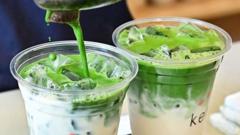Matcha's rise to fame is transforming into a global phenomenon, with its vibrant green hue finding its way into beverages and desserts across the world. From Starbucks lattes in the UK to Krispy Kreme doughnuts in Singapore, the matcha craze, amplified by social media influencers sharing diverse recipes and brewing tips, is making waves. The trend is notably encapsulated by the viral "Matcha Tok" hashtag, which has garnered millions of online views.
This increasing enthusiasm is interwoven with Japan's resurgence in tourism. As the Japanese yen experiences a downturn, travelers flock to the country, further increasing demand for its renowned tea products. “Our matcha supplies are depleting in days rather than weeks,” says Lauren Purvis, a U.S. tea importer, highlighting the desperation among cafes as they request hefty daily supplies to meet consumer cravings.
Despite the enthusiasm, challenges lurk behind the scenes, including poor harvests influenced by significant heatwaves and the burden of U.S. tariffs on Japanese imports. Such factors are driving prices upwards for matcha, which has long been revered for its health benefits and rich flavor profile. The traditional production method, which involves shading tea leaves for weeks to nurture the unmatched "umami" flavor before grinding them into a fine powder, is now under strain.
Regions like Kyoto, vital to matcha production, are grappling with crop failures due to extreme weather, while an aging farming population creates labor shortages. Retailers have responded to relentless rising demand by imposing purchasing caps; for instance, the Kyoto-based Camellia Tea Ceremony now restricts buyers to a single tin of matcha.
Tea master Rie Takeda, working with Chazen, reflects on the increasingly strained supply chains, noting that orders which used to arrive quickly now take significantly longer. To cope with rising expenses, Chazen has raised their matcha prices by approximately 30% in 2023, a trend echoed across various retailers.
In the wake of these changes, there’s a movement promoting responsible consumption of matcha, with advocates advising against stockpiling and unscrupulous reselling. Many also stress the importance of appreciating high-grade matcha in its pure form rather than diluting its flavor in culinary applications.
To balance the demand, the Global Japanese Tea Association advocates for consumers to opt for lower-grade matcha suited for cooking, which can alleviate some market pressure. With the looming threat of new U.S. tariffs on Japanese imports, there’s a growing call for specialty teas to be exempt from such regulations.
For matcha distributors like Purvis, facing a surge in pre-tariff orders underscores the industry's volatility. However, there’s a glimmer of hope: some believe the current matcha boom may stabilize within a couple of years, allowing for better supply and more stable pricing. As the world watches this green tea sensation unfold, the tension between thriving demand and limited supply remains a pivotal narrative in the matcha landscape.
This increasing enthusiasm is interwoven with Japan's resurgence in tourism. As the Japanese yen experiences a downturn, travelers flock to the country, further increasing demand for its renowned tea products. “Our matcha supplies are depleting in days rather than weeks,” says Lauren Purvis, a U.S. tea importer, highlighting the desperation among cafes as they request hefty daily supplies to meet consumer cravings.
Despite the enthusiasm, challenges lurk behind the scenes, including poor harvests influenced by significant heatwaves and the burden of U.S. tariffs on Japanese imports. Such factors are driving prices upwards for matcha, which has long been revered for its health benefits and rich flavor profile. The traditional production method, which involves shading tea leaves for weeks to nurture the unmatched "umami" flavor before grinding them into a fine powder, is now under strain.
Regions like Kyoto, vital to matcha production, are grappling with crop failures due to extreme weather, while an aging farming population creates labor shortages. Retailers have responded to relentless rising demand by imposing purchasing caps; for instance, the Kyoto-based Camellia Tea Ceremony now restricts buyers to a single tin of matcha.
Tea master Rie Takeda, working with Chazen, reflects on the increasingly strained supply chains, noting that orders which used to arrive quickly now take significantly longer. To cope with rising expenses, Chazen has raised their matcha prices by approximately 30% in 2023, a trend echoed across various retailers.
In the wake of these changes, there’s a movement promoting responsible consumption of matcha, with advocates advising against stockpiling and unscrupulous reselling. Many also stress the importance of appreciating high-grade matcha in its pure form rather than diluting its flavor in culinary applications.
To balance the demand, the Global Japanese Tea Association advocates for consumers to opt for lower-grade matcha suited for cooking, which can alleviate some market pressure. With the looming threat of new U.S. tariffs on Japanese imports, there’s a growing call for specialty teas to be exempt from such regulations.
For matcha distributors like Purvis, facing a surge in pre-tariff orders underscores the industry's volatility. However, there’s a glimmer of hope: some believe the current matcha boom may stabilize within a couple of years, allowing for better supply and more stable pricing. As the world watches this green tea sensation unfold, the tension between thriving demand and limited supply remains a pivotal narrative in the matcha landscape.



















